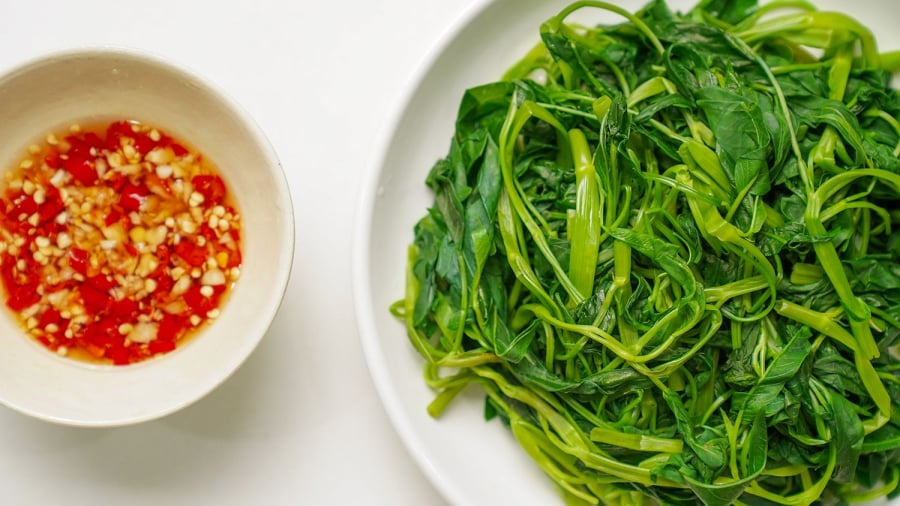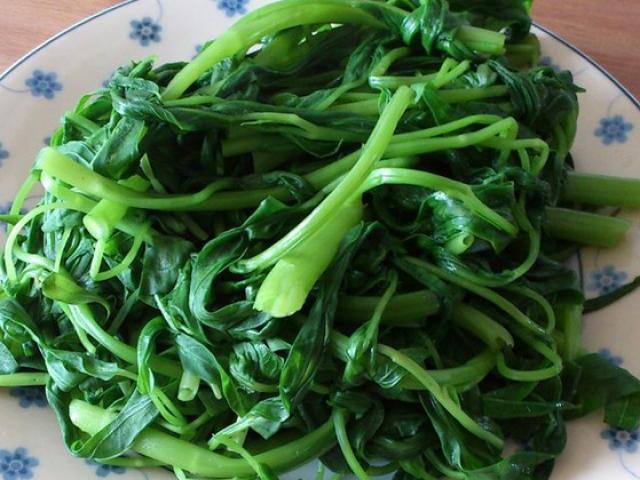Add salt to the pot of boiling water for boiling vegetables
By adding salt to the boiling water, you can harness an element that helps the water heat up quickly, thus maximizing the boiling time of the vegetables.
This ensures that the water spinach is evenly cooked, crispy and retains its fresh green color without becoming limp or red from prolonged boiling. Moreover, boiling water spinach with salt also makes the boiled vegetable dish in your family more attractive and flavorful.

Add salt to the water as it starts to boil, then add the water spinach when the water is vigorously boiling. When the vegetables are cooked, remove them and soak them in a bowl of ice water to preserve their vibrant green color and ensure their crispy texture.
Add vinegar/lemon juice to the pot of boiling water for boiling vegetables
By adding a little vinegar or lemon juice to the pot of boiling water for boiling water spinach, the boiled vegetable dish will become greener and more enticing. Using a small amount of vinegar or lemon juice helps to preserve the color of the vegetables without affecting their original flavor.

The process is very simple, just add about 2 teaspoons of lemon juice or vinegar to the pot of boiling water for boiling vegetables, then bring it to a boil. Once the water is boiling, add the vegetables and remove them when they are cooked to the desired level.
Boil the vegetables in a large amount of water
To ensure that boiled water spinach is crispy and green, it needs to be boiled in a large amount of water. We also need to cook the vegetables until they are just tender, not overcooked or undercooked. If they are undercooked, the water spinach will still be stringy and may turn dark. Conversely, if they are overcooked, the water spinach will lose its color and become pale yellow.
After boiling, immerse the vegetables in cold water to maintain their crispness and vibrant green color. Prepare a bowl of cold water with ice (you can also add a few pieces of lime peel to make the vegetables more fragrant). Then, place the vegetables in the bowl of cold water and let them soak until the water is no longer cold. Finally, remove the vegetables and let them drain.

The simplest way is to use plenty of water during the boiling process and boil only a small amount of vegetables at a time. When boiling a small amount of vegetables in a large amount of water, the temperature quickly increases and the vegetables cook faster.
On the contrary, if you boil a large amount of vegetables in a small amount of water, the water will take longer to boil and the vegetables will cook more slowly, resulting in changes in color. The red color in the vegetables is formed by the oxidation of polyphenols due to prolonged boiling. This makes the vegetables look unappetizing and less tasty.
Another way is to add a little salt before adding the vegetables to the pot of boiling water. This helps enhance the flavor of the dish, retain more vitamins and nutrients in the vegetables, and ensure that they have the desired fresh green color.
The perfect ratio of salt to water is 1 teaspoon of salt: ½ liter of boiling water.



































